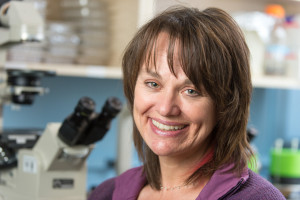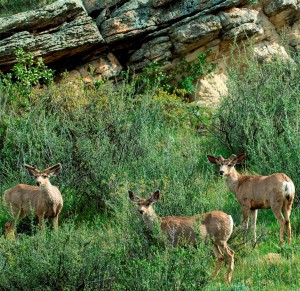When Candace Mathiason was growing up on an Angus ranch near Torrington, Wyo., she developed a love for animals, and even tried to help with brucellosis testing at a local veterinarian’s office where her mom worked.

“I was bound to be a scientist,” she said. “I like mysteries and puzzles.”
Now she’s putting that love for animals and mysteries to use by trying to crack the code of chronic wasting disease in deer. Her discoveries could translate into new ways to help combat similar diseases in humans.
Mathiason is one of two researchers in CSU’s College of Veterinary Medicine and Biomedical Sciences receiving a CVMBS-Zoetis Early Career Research Award at the college’s annual Research Day. The event showcases through posters and presentations the research efforts of students and other young investigators in the college. It will run noon to 6:30 p.m. Saturday at the Hilton Fort Collins; Mathiason and fellow awardee, Elizabeth Ryan, will kick off Research Day with talks about their work.
Nontraditional path
Mathiason, an assistant professor in the Department of Microbiology, Immunology and Pathology, has followed a nontraditional career path leading to groundbreaking research in how chronic wasting disease (CWD) is transmitted between deer.
She earned degrees in microbiology and parasitology, then managed CSU’s Retrovirus and Prion Research Lab for about 20 years. Mathiason went back to school in 2006, earning her doctorate in prion pathobiology from CSU and studying with Dr. Edward Hoover, a University Distinguished Professor and leading expert on prions, the misfolded proteins that cause death by inhibiting the ability of neurons to communicate.
“Prions cause neurons to degenerate by forming plaques in the central nervous system,” Mathiason explained. “A rogue form of the prion protein, by some mechanism we don’t fully understand, changes the structure of normal prion proteins and kills cells. As neurons die, holes are formed in the brain and other neural tissue, disrupting the normal processes of the cells. Some people think of it as a sort of zombie state, of something coming in and taking over a system.”
Spread of CWD

Deer with CWD often hold their heads low, drool, look lost and lose weight. The disease, first observed in captive elk in the late 1960s, has spread from its epicenter in northern Colorado to 23 states, two Canadian provinces and South Korea.
While working on her Ph.D., Mathiason demonstrated for the first time that prions are carried in bodily fluids – blood and saliva – and can be transmitted between deer without direct bodily contact, through things like bedding and feed.
Her team also has gathered evidence that CWD can be transmitted from a doe to fawns; she is working with collaborators to determine if this occurs in the wild. Mathiason likewise is collaborating with the U.S. Department of Agriculture to mitigate spread of CWD. Her research has yielded a blood test for CWD in deer.
A current investigation seeks to track prions from entrance in the body to time of death. Understanding prion pathways and the cells involved will unveil “who are the active players in the bloodstream,” Mathiason said.
‘Covert prions’
Her presentation at Research Day on Saturday will focus on “covert prions,” or those that are in the body but are not causing symptoms of disease.
Mathiason said she hopes to better understand biological mechanisms associated with covert prion transmission and believes this could help shed light on similar protein-misfolding diseases in people – perhaps leading to new diagnostics and treatments. These human ailments include Alzheimer’s disease, Parkinson’s disease, amyotrophic lateral sclerosis and diabetes.
“Candace Mathiason’s career started as the cornerstone research scientist in a highly productive research laboratory, and she has matured into an independent, creative, productive principal investigator,” said Dr. Sue VandeWoude, associate dean for research in the college.
Research funding
Mathiason has received funding from the National Institutes of Health and U.S. Department of Agriculture at a time when federal grants are extremely competitive, and she has been first or senior author on a large number of high-impact scientific manuscripts, VandeWoude noted.
“Her work on mechanisms of transmission of prion infections has been pivotal in our understanding about how this agent is spread, with significant implications for control of diseases like chronic wasting disease of cervids, mad cow disease, and several fatal neurodegenerative diseases in people,” VandeWoude said.
Managing a lab for two decades has been tremendously valuable to her research, Mathiason said.
“I feel fortunate. A lot of people don’t get that experience, and I think it’s been very helpful,” she said. “You can be a late bloomer in life – don’t give up.”